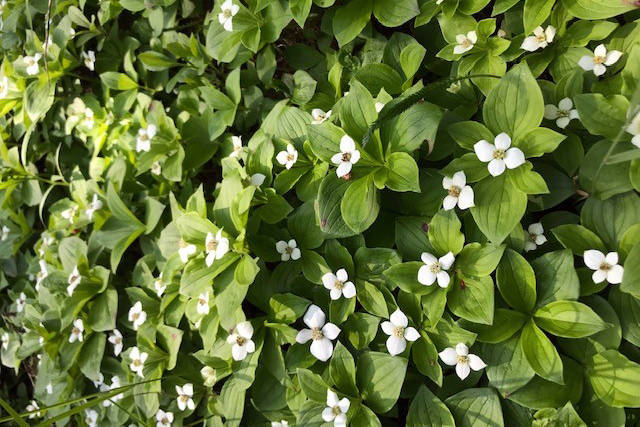This summer, I traveled from the East Coast to the Kenai Peninsula to intern with the biology program at the Kenai National Wildlife Refuge. As a biology intern, I have been exposed to Alaska in a different way than most visitors.
One of my early experiences involves going out on lakes around the peninsula and surveying the water for elodea, a plant that clogs the waterways and reduces habitats for spawning salmon.
We were surveying at Daniels Lake when we stopped at one of the many islands for lunch. We had seen a picnic table from the water and thought it would provide a nice spot to have a little solid ground under our feet.
That day, I was out on the water with another biology intern and Matt Bowser, the refuge entomologist and a good botanist. I noticed that the ground was covered by small green plants with little white “flowers.” This was not the first time that I had seen these plants as they have popped up everywhere since I arrived in Alaska.
Matt has so much knowledge about the plants found on the peninsula, so I knew that he would be the one to ask to finally determine the identity of this species.
Always the one to take an opportunity and turn it into a learning experience, Matt immediately bent down and pulled off a leaf and a petal. He asked me where else I might have seen a plant with this shape of leaves and petals, hinting that it might be found on the East Coast.
All of a sudden, it was like a light bulb went off in my head. I had seen this plant before, but in a very different form.
Matt confirmed what I had apparently already known, that the small herbaceous plant covering the ground here in Alaska was in the same genus as a tree that flowered every spring in my front yard back home in Connecticut. Cornus canadensis is a member of the dogwood family and is also known as bunchberry or Canadian dwarf cornel.
This species is distributed throughout most of Alaska (except in the high Arctic), Canada and even parts of Asia. This distribution can largely be explained by the cold hardiness of the species, allowing it to be found in areas where other members of its family cannot persist.
Within that distribution, Cornus canadensis is most common within spruce and birch forests. Areas affected by heavy spruce bark beetle damage allow the species to thrive, as the canopy opens up and more light reaches the forest floor.
The Latin or scientific name of the species also provides salient information. Cornus translates to horn, which describes the tendency of dogwood wood to be very hard.
Canadensis translates to “of Canada,” which refers to the tendency of this species to be associated with the region of Canada. Cornus canadensis is the only species of dogwood within the Cornus genus that is herbaceous.
When we got back to the office that day, I spent some time going through literature provided by Matt and online resources. What looked like little white flowers are, in fact, bracts. Bracts are not truly petals − they instead function to attract pollinators to the more cryptic flower of the plant.
A familiar example of this would be poinsettias in which those bright red “flowers” are actually bracts that attract the pollinators. The true flower is above the bracts and will develop into a cluster of red berries, giving credence to its alternate name of bunchberry.
The palatability of the berries is highly varied. The Dena’ina use the word ch’entq’ena to refer to the plant, which means “crunchy” or “hard to chew.” The Alutiiq call the plant atangqurhnaq which means “gristly.” Alutiiq may add the raw berries to ice cream, or create jelly or jam from the berries.
The berry is not poisonous but Alaska Natives tend to avoid it due to its tendency to be dry, mealy and contain large seeds. However, a variety of wildlife species feed on the berries including birds, squirrels and snowshoe hares. The foliage itself may be eaten by caribou and moose, although this isn’t very common.
This was a really interesting learning experience for me. Never would I have guessed that a plant familiar to me back home is also present in Alaska but in a totally different form. That I was able to correctly identify the plant based on my remembrance of a different member of the same genus over 5,500 miles away felt like an accomplishment.
This long-distance connection between the herbaceous dogwood here on the Kenai Peninsula and the dogwood tree that I grew up with piqued my interest. It led me to discover uncommon traits about a common species.
Rachel Beach is a biological intern at Kenai National Wildlife Refuge this summer. She is also a senior in Fisheries and Wildlife Conservation at the University of Connecticut–Storrs. Find more Refuge Notebook articles (1999–present) at https://www.fws.gov/refuge/Kenai/community/refuge_notebook.html.

